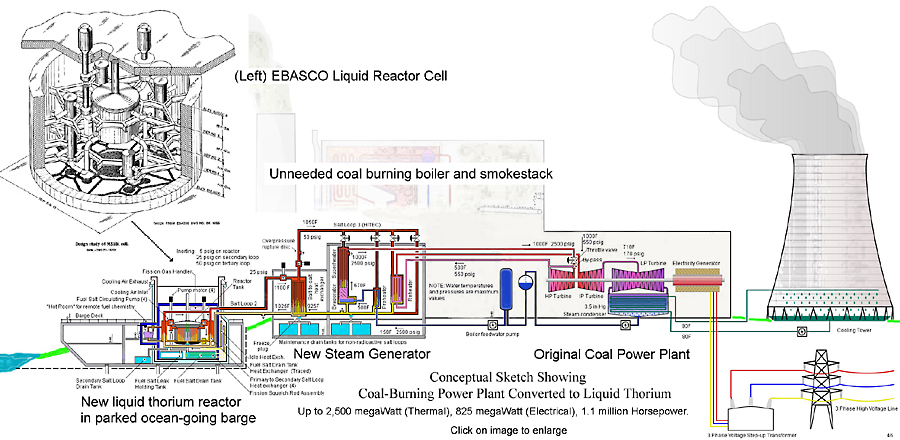
The purpose of this page is to describe the mobility related functions of the reactor barge.
coal2thorium.com 
The purpose of this page is to describe the mobility
related functions of the reactor barge.
Reactor Refueling, Repair, and Disposal

Molten salt reactors can run at an average of 80% maximum capacity for 30 years with annual refuelings between refurbishments. Refurbishment would consist at least of replacing graphite that has been degraded by exposure to radiation and the cleansing of the fuel salt of the fission products created by the fission of its thorium fuel. It is envisioned that a spent Reactor Barge would be immediately replaced with a fresh barge and the spent Reactor Barge would be towed away to a service center by the tug that brought the fresh barge. The refurbished barge would then be leased to some other power plant.
What would be involved:
The secondary heat transfer salt lines between the Reactor Barge and the steam generators contain clear, non-radioactive heat transfer salt.
To free up the Reactor Barge, the following steps would have to be executed prior to the arrival of the fresh Reactor Barge:
1. The reactor is deactivated by having the overtemperature freeze plug in the bottom of the reactor deliberately opened, allowing the primary salt that carries the dissolved thorium to drain into the primary salt cooling drain tank (blue) located below the reactor. Once the fuel salt is more than a couple of feet away from the nuclear graphite moderator rods in the reactor (black), the thorium can no longer sustain fission and will begin to cool, eventually becoming solid. (Notice passive heat exchangers.)
2. The primary heat exchanger in the barge's containment cell would have its salt drained into the blue drain tank located outside the containment cell.
3. The secondary and tertiary heat transfer salts would be drained into their tanks (blue pairs of tanks under steam generators). (All tanks have gas-fired package heaters to re-melt the salt so it will be liquid when needed later.)
4. Then, the supply and return lines between the two buildings would be disconnected and capped off.
5. The temporary parking slip for the Reactor Barge would then be re-excavated, the barge re-floated and then towed away to somewhere else in the world for either refurbishment and refueling or disassembly for total disposal by properly trained and equipped experts.
Much less expensive than site decommissioning and radiation decontamination.
(Click on image for larger view.)